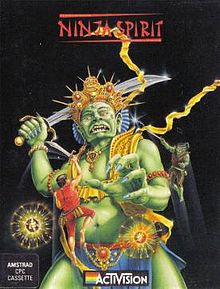Ninja Spirit
Ninja Spirit, known in Japan as Saigo no Nindou (最後の忍道), is a 1988 platform arcade game developed and published by Irem.
 Cover of the Amstrad CPC version | |
| Developer(s) | Irem Bits Studios (Game Boy) |
|---|---|
| Publisher(s) | Irem NEC |
| Composer(s) | Masahiko Ishida[1] |
| Platform(s) | Arcade, TurboGrafx-16, Amiga, Amstrad CPC, Atari ST, Commodore 64, Game Boy,[2] ZX Spectrum, Virtual Console |
| Release | 1988 |
| Genre(s) | Platform game |
| Mode(s) | Single-player |
Gameplay
.png.webp)
Tsukikage's journey takes him through seven stages, varying from woodlands, wastelands, swamps, temples, and cliffs. Each stage begins with the player slashing his way to the end until he confronts a level boss.
The ninja is always armed with the katana, Righteous Cloud, which can be fluidly used to attack in all directions. Extra weapons include the Swirling Leaf (shurikens), the Bamboo Thunder (bombs), and the Rising Dragon/Shouryu (kusarigama). There are also several power-up items, such as one unleashing multiple ninja ghosts to assist the player.
Story
The game's hero, Tsukikage (月影), is a young ninja who lost his father to a mysterious half-man half-beast creature. The plot of Ninja Spirit is based on the quest of his way to avenge his father in an alternative feudal Japan.
Ports and related releases
The game was successfully ported onto multiple platforms. The most popular port is the TurboGrafx-16 format which includes two styles of mode: the PC engine mode which players lose one ninja only if all 5 energy points are used up (certain enemies can kill Tsukikage with one hit), and the Arcade mode, which is a more challenging mode where any attack are grounds for players to lose one ninja instantly.[3] That version was ported to the Nintendo Wii's Virtual Console on May 14, 2007, was delisted on March 30, 2012 and was available again on September 17, 2013 in Japan and on September 19, 2013 in North America and Europe. The same version was republished to the Nintendo Wii U's Virtual Console on January 14, 2015 in Japan, July 27, 2017 in North America and August 10, 2017 in Europe.[4][5][6]
Ninja Spirit later appeared in the Japan-only Game Boy title, Shuyaku Sentai Irem Fighter along with other characters from the game, as well as characters from three other Irem franchises: R-Type, Mr. Heli, and Hammerin' Harry.
Soundtrack
The original soundtrack for the game was released on December 21, 1988 by Alfa Records.[7]
Reception
In Japan, Game Machine listed Ninja Spirit on their September 1, 1988 issue as being the fifth most-successful table arcade unit of the year, outperforming titles like The Main Event.[9]
In Issue 15 of Electronic Gaming Monthly, both Ninja Spirit and Ys Book I & II were the first games to receive a perfect 10 in the magazine's history.[10] In 2010, CraveOnline featured this version in the article Top 10 Ninja Games Of All Time, commenting: "Ninja Spirit for the TurboGrafx-16 was a lot like “Legend of Kage” on the NES, except better in every way ... both challenging and sort of relaxing at the same time."[11]
References
- Tanaka, Haruhisa; x68303 (25 March 2014). "R-Type Creator Interview (クリエイターインタビュー): Masahiko Ishida (石田雅彦)". Shooting Gameside (in Japanese). Vol. 9. Micro Magazine. pp. 58–65. ISBN 978-4896374551. (Translation by Shmuplations. Archived 2018-01-17 at the Wayback Machine).
- Saigo no Nindou: Ninja Spirit (Game Boy) at GameFAQs
- https://www.nintendo.com/games/detail/rWat9tfcXQAD2sJdUXR045uwWj4pAqwf
- https://www.nintendo.co.jp/titles/20010000012167
- https://www.nintendo.com/games/detail/ninja-spirit-wii-u
- https://www.nintendo.co.uk/Games/TurboGrafx/Ninja-Spirit--278403.html
- 15A3-3 | Saigo no Nindou - VGMdb
- Normal, Abby (November 1990). "TurboGrafx-16 ProView: Ninja Spirit" (PDF). GamePro. pp. 112–113.
- "Game Machine's Best Hit Games 25 - テーブル型TVゲーム機 (Table Videos)". Game Machine (in Japanese). No. 339. Amusement Press, Inc. 1 September 1988. p. 21.
- https://www.retromags.com/magazines/usa/electronic-gaming-monthly/electronic-gaming-monthly-issue-15
- Top 10 Ninja Games Of All Time Archived 2015-07-11 at the Wayback Machine, CraveOnline, September 18, 2008
External links
- Ninja Spirit at MobyGames
- Ninja Spirit at SpectrumComputing.co.uk
- Ninja Spirit Strategy Guide (TurboGrafx-16) at TurboPlay Magazine Archives